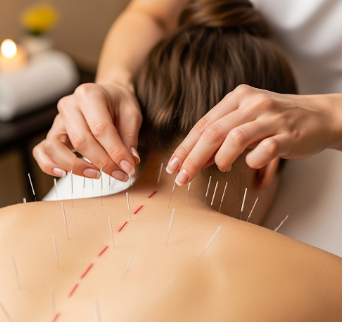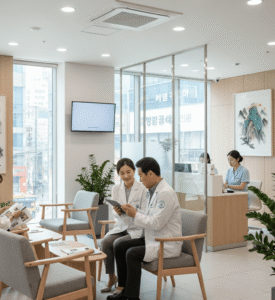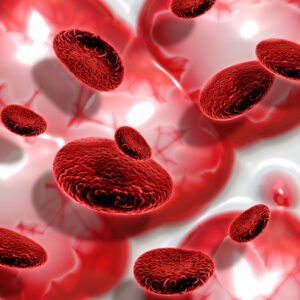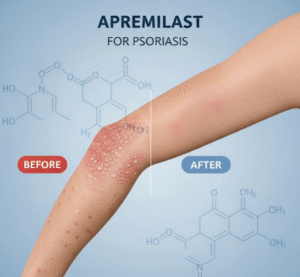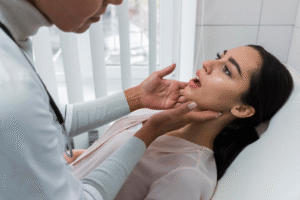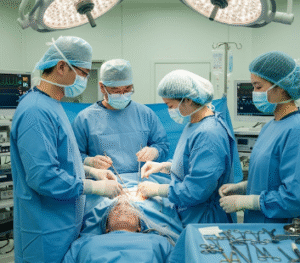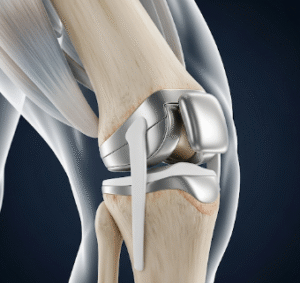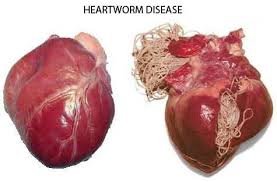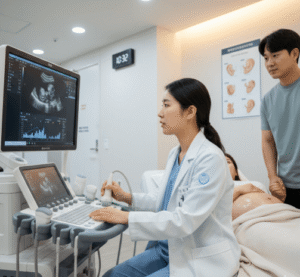What It Is
Acupuncture is a therapeutic technique that originated in Traditional Chinese Medicine (TCM) more than 2,500 years ago and is now practiced worldwide, including in Korea. The treatment involves inserting very fine, sterile needles into specific points on the body (called acupoints) to influence energy flow (known as Qi, or “Chi”) and restore balance in the body.
According to traditional theory, health is maintained when energy flows freely along channels called meridians. When the flow is disrupted, illness, pain, or dysfunction may occur. By stimulating precise points, acupuncture aims to re-establish harmony, promote healing, and relieve symptoms.
Modern science explains acupuncture through neurophysiological mechanisms. Needle stimulation triggers the release of endorphins, neurotransmitters, and natural anti-inflammatory substances, improving circulation, reducing pain, and enhancing the body’s self-healing capacity.
Today, acupuncture is used as both a standalone treatment and as a complement to modern medicine. It is recognized by the World Health Organization (WHO) and widely available in Korea, where both traditional Korean medicine and Western medical systems coexist.
Why It’s Done
Acupuncture is used for a broad range of conditions, from chronic pain to mental health and wellness.
Common reasons for acupuncture include:
- Pain management: chronic back pain, knee pain (osteoarthritis), neck pain, shoulder stiffness, sciatica, migraines, tension headaches.
- Sports injuries: sprains, strains, tendonitis, rehabilitation after injuries.
- Neurological conditions: peripheral neuropathy, post-stroke recovery, trigeminal neuralgia.
- Women’s health: menstrual cramps, infertility support, menopause symptoms.
- Digestive issues: irritable bowel syndrome (IBS), indigestion, nausea, post-surgery recovery.
- Mental health and wellness: anxiety, depression, insomnia, stress reduction.
- Addiction treatment support: smoking cessation, alcohol withdrawal, weight management.
Benefits of acupuncture include:
- ➤ Natural, drug-free therapy with minimal side effects.
- ➤ Improves circulation and reduces inflammation.
- ➤ Boosts immune system and overall energy.
- ➤ Enhances mental well-being and relaxation.
- ➤ Complements modern treatments for complex conditions.
Alternatives
While acupuncture is effective for many people, other therapies may also be considered:
- ➤ Physical therapy and rehabilitation – strengthening, mobility, and posture correction.
- ➤ Massage therapy and chiropractic care – soft tissue and structural adjustments.
- ➤ Pharmacological treatment – painkillers, anti-inflammatory drugs, antidepressants.
- ➤ Other traditional medicine methods – cupping, herbal medicine, moxibustion.
- ➤ Lifestyle changes – exercise, diet, mindfulness, and yoga.
Acupuncture is often combined with these alternatives rather than replacing them, particularly in integrative medicine clinics in Korea.
Preparation
Preparing for acupuncture is simple but important for comfort and effectiveness:
- ✅ Eat lightly before the session; avoid going on an empty stomach.
- ✅ Wear loose, comfortable clothing for easy access to acupuncture points.
- ✅ Bring medical history and discuss current medications and conditions.
- ✅ Avoid stimulants or alcohol before treatment.
- ✅ Set realistic expectations – acupuncture usually requires multiple sessions for best results.
How It’s Done
An acupuncture session typically lasts 20–60 minutes and is performed by a licensed practitioner.
Step-by-step process:
- Consultation: The practitioner assesses symptoms, medical history, and performs diagnosis (pulse check, tongue observation, etc.).
- Selection of Acupoints: Based on the condition, specific points along the meridians are chosen.
- Needle Insertion: Very fine, sterile, single-use needles are gently inserted into the skin at varying depths.
- Needle Manipulation: The practitioner may twirl, move, or apply heat/electric stimulation to enhance effects.
- Retention Period: Needles remain in place for 15–30 minutes while the patient relaxes.
- Removal: Needles are removed painlessly, and the session ends with aftercare advice.
Techniques & Variations:
- Electroacupuncture: Needles are stimulated with mild electrical current.
- Auricular acupuncture: Focuses on points in the ear to treat pain, addiction, or stress.
- Scalp acupuncture: Used for neurological conditions such as stroke rehabilitation.
- Moxibustion (common in Korea): Burning dried mugwort (moxa) near acupoints to add heat.
- Cupping therapy: Often combined with acupuncture for pain relief and detoxification.
Recovery
Acupuncture does not require downtime, and most patients resume normal activities immediately.
Typical recovery experience:
- ✔️ Mild soreness at needle sites, lasting a few hours.
- ✔️ Relaxation or slight fatigue after the session, often described as a “post-acupuncture calm.”
- ✔️ Gradual improvement over several sessions, particularly for chronic conditions.
- ✔️ Emotional balance and improved sleep reported by many patients.
Aftercare Tips:
- Drink plenty of water.
- Rest if feeling tired.
- Avoid intense workouts immediately after treatment.
- Continue regular sessions for cumulative benefits.
Possible Complications
When performed by a trained professional, acupuncture is very safe. However, potential issues include:
- ⚠️ Mild bruising or soreness at needle sites.
- ⚠️ Temporary dizziness or lightheadedness (usually resolves quickly).
- ⚠️ Rare infections if non-sterile needles are used (avoided in professional clinics).
- ⚠️ Excessive bleeding in patients with clotting disorders or on blood thinners.
- ⚠️ Improper technique complications (extremely rare) such as nerve injury or pneumothorax.
Treatment Options in Korea
Korea offers some of the world’s most advanced and standardized acupuncture care, thanks to its dual healthcare system that integrates Western medicine with Traditional Korean Medicine (TKM).
- 🏥 Availability: Acupuncture is widely available in both university hospitals and specialized Korean medicine clinics.
- 🏥 Trained practitioners: Licensed Korean medicine doctors undergo extensive training, blending traditional theory with modern medical science.
- 🏥 Integration with hospitals: Patients can receive acupuncture alongside physical therapy, surgery, or pharmacological care.
- 🏥 Specialized treatments: Korean acupuncture often combines moxibustion, cupping, and herbal medicine for holistic results.
- 🏥 Medical tourism: International patients seek acupuncture in Korea for its affordability, safety, and reputation in treating pain, infertility, and stress-related conditions.
- 🏥 Cost-effectiveness: Sessions in Korea are generally cheaper than in Western countries while maintaining high standards of hygiene and professionalism.
Highlights
- ➤ Acupuncture is an ancient therapy using fine needles to stimulate acupoints.
- ➤ Used for pain, neurological disorders, stress, fertility support, and wellness.
- ➤ Safe, natural, and drug-free treatment with minimal side effects.
- ➤ Sessions last 20–60 minutes, often requiring multiple treatments.
- ➤ Complications are rare when performed by licensed professionals.
- ➤ Korea integrates acupuncture into mainstream healthcare with global recognition.

